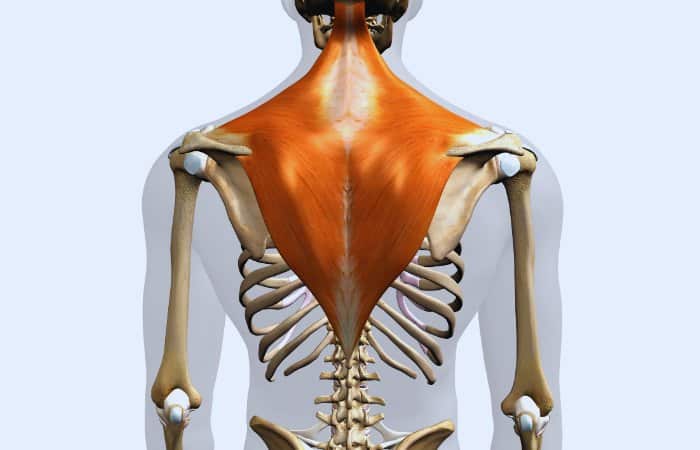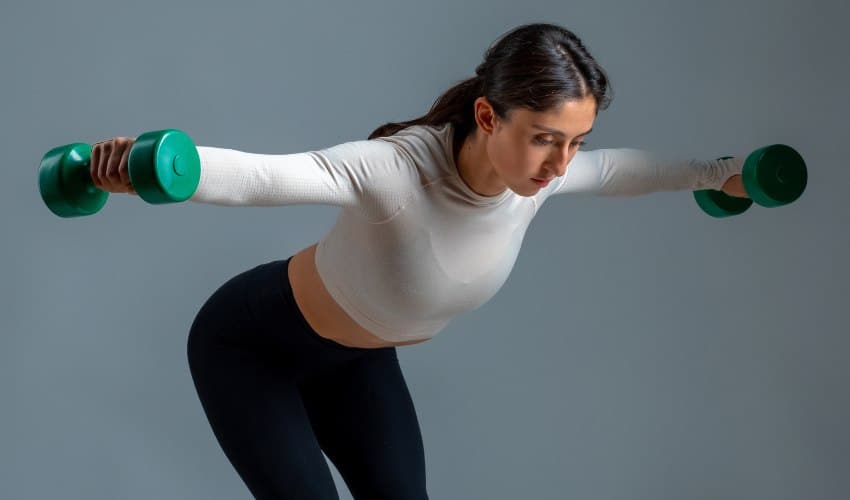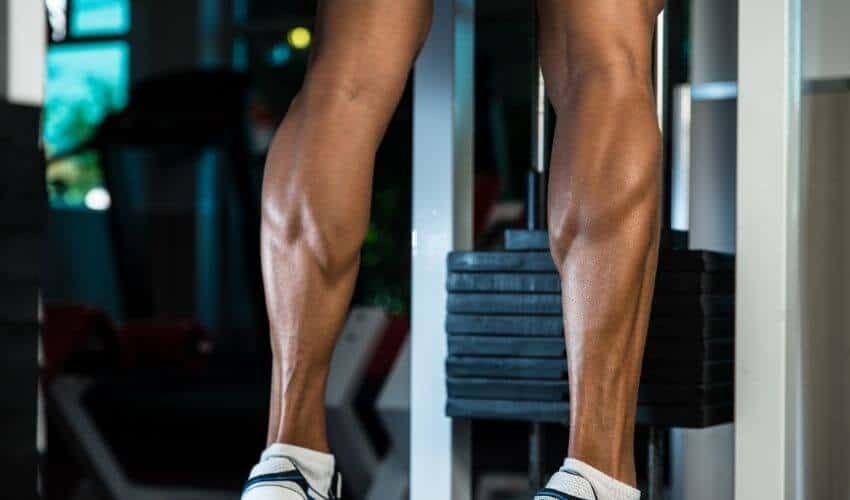In This Article
Lower traps anatomy | Best lower trap exercises | Effective workout tips | Bottom line | FAQs
The lower trap muscle plays an important role in maintaining good posture, shoulder stability, and overall back strength, which is often overlooked, causing back pain and shoulder discomfort.
In this article, we will explore the nine best strengthening lower trap exercises, along with some effective workout tips and FAQs to help improve your posture and overall back and shoulder strength.
Anatomy of the Lower Trapezius Muscle
Let’s get nerdy and look closer at the lower trapezius muscle. This muscle is located in the middle and lower part of our back and is responsible for keeping our shoulder blades in the correct position. Think of it as a “backpack strap” that helps hold your shoulders in place.

The lower trap is a kite-shaped muscle that starts at the bottom of your shoulder blade and extends down to the middle of your spine.
We need to properly stretch and contract the muscle fibers to get an effective lower trap workout.
For the lower trap, we can see the muscle fibers run somewhat horizontally and on a downward angle, which we can hit by keeping our shoulder angle between 90 to 120 degrees.
In other words, we can get optimal lower trap muscle activation by focusing on exercises that involve squeezing the shoulder blades together and pulling them down towards your hips.
9 Best Lower Trap Exercises

Here’re the nine best lower trap exercises for posture and bodybuilding.
1. Plate Raises
- Stand with your feet shoulder-width apart and grab the edge of the weight plate with your hands extended in front of your chest.
- Keep your knees softly bent, hips back, and always core tight.
- Inhale and raise the plate all the way to the overhead position.
- Then lower the plate to the starting position as you exhale.
Tip
Use a lightweight plate. Perform the exercise in a slow, controlled fashion. It also trains your front deltoids.
2. Prone Y Raise
- Grab a pair of light dumbbells or plates with a neutral grip and lie on an incline bench in a prone position (face-down). Let your arms extend straight toward the floor.
- Inhale, raise your arms upward and out from your shoulders to create a “Y” shape.
- Pause at the top and lower your arms to the initial position.
Tip
It’s one of the best lower trap exercises you can do with or without weights on the bench or floor.
3. Face Pull Press
- To begin, grab the rope handles (which settings at the face height) with a neutral grip and take a few steps back to eliminate the slack of the cable rope.
- Keeping your core tight, pull the cable toward your face and then push your hands up and out towards the ceiling, squeezing your shoulder blades together.
- Lower your arms to the face-pulled position and then stretch your arms to the starting position.
- Keep the tension on your lower traps throughout the movement. It engages your middle traps as well.
Tip
Avoid too much curve in the lumbar spine (i.e., lower back). You can also do this exercise in a seated position for balance.
4. Prone Reverse Fly
- Lye on a face-down position on a flat bench or on the floor with your arm horizontal and externally rotated (thumbs pointing up).
- Raise your arms upward, squeezing your shoulder blades together.
- Take a little pause at the top and lower your arms. Repeat. You’ll also activate your rear delts beside traps.
Tip
Hold lightweight plates or dumbbells to increase resistance. Keep your arms at about 90 to 120-degree angles to get maximum lower and middle trap activation.
5. Cable Y Raise
- To begin, stand facing a cable machine with the pulley at its lowest setting.
- Grab the handle with both hands, palms facing each other, and arms straight in front of you. Take a step backward and stand with your feet shoulder-width apart.
- Keeping your back flat and core tight, inhale and lift your arms up and out to form a “Y” shape with your body.
- Squeeze your shoulder blades together at the top, then slowly lower your arms to the starting position and exhale.
Tip
Keep your arms straight and your shoulders down throughout the movement. You can also use lighter weights or resistance bands to achieve proper form and control.
Related: 50 Best Shoulder Exercises of All Time
6. T-Bar Row with Handle
- Stand with your feet shoulder-width apart, holding the T-bar handle with both hands in a neutral grip.
- Bend your hips at about 90 degrees, knees slightly bend, and extend your arms straight under your shoulder. Keep your back flat and chest up throughout the exercise.
- Inhale and pull the T-bar towards your chest, squeezing your shoulder blades together at the top of the effort.
- Lower the T-bar to the initial position and exhale.
Tip
Bend your torso about 90 degrees and squeeze your shoulder blades at the top for 3 seconds to fire up the low and middle traps.
7. Pull-Up Bar Reverse Shrugs
- Hang from a pull-up bar with an overhand grip with your hands shoulder-width apart.
- Keeping your arms straight, pull your shoulder blades down and back to slightly raise your body towards the bar.
- Hold the position for a second, then slowly lower your body and repeat.
Tip
Make sure you’re recruiting the lower traps muscle. Hold the shoulder blades squeezed (i.e., scapular retraction) position for a few seconds to increase the intensity.
8. Suspension Trainer Y Raise
- To start, hold a suspension trainer handle in each hand (which is in an overhead position), palms facing each other.
- Keeping your body straight, lean backward with your arms extended in front of you, elbows slightly bent.
- Pull through your shoulder blades, and bring your body vertical while simultaneously extending your arms overhead and side to make a “Y” shape.
- Slowly lower your arms and bring yourself to the initial position and repeat.
Tip
Engage your core muscles to maintain stability throughout the exercise, and keep your shoulders down to isolate the lower traps, and to a lesser degree the back muscle.
Related: The 11 Best Back Exercises (Dumbbells Only)
9. One-Arm Straight-Arm Pushdown
- Stand facing a cable pulley machine with the pulley fixed at shoulder height. You can also use a resistance band.
- Grab the handle with one hand, palm facing down, and keep your body upright.
- Pull your shoulder blade down and back with your arm straight to engage your lower traps.
- And then push the handle down towards your hip, squeezing your lower traps.
- Slowly release back by elevating your shoulder like a shrug. Repeat and switch arms.
Tip
Try using a lighter weight and focusing on the mind-muscle connection to ensure you work the right muscle, not the upper traps.
Tips to Get a More Effective Lower Trap Workout
Follow these tips to increase the effectiveness of your lower trap training.
Maintain Proper Posture
With weak lower traps (and relatively strong upper traps), it’s common to make mistakes like shrugging (scapular elevation) during upper body exercises. Keep your shoulders back and down (i.e., scapular depression) and avoid excessive curvature in the lower back when performing the exercises.
Instead of using heavy resistance, use a manageable weight that you can handle properly without compromising your form. Your aim should be to feel the contraction in your lower traps in every rep.
Shoulder Angle
When we alter the shoulder abduction angle (upward lateral movement of the arm out to the side, away from the body) while performing the lower exercises, it can change the relative percentage of muscle activation and usage of muscle fibers.
Several studies found that between 75 to 120 degrees, we tend to see the most muscle activation for the lower traps. [1]
But in general, we see that 90 to 120 degrees typically come out as the best option.
Shoulder Rotation
Okay, now we look at the rotation of the shoulder. There’re three shoulder rotation movements we have while training the low traps — palm facing down (neutral), thumb pointing up (externally rotated), and thumb pointing down (internally rotated).
If we look at the research, it’s pretty interesting that doing the exercises at a neutral grip with a 90-degree shoulder angle gives the lowest relative activation of the lower traps. In contrast, doing the exercise at the same angle with the arms externally rotated gives even more recruitment of the lower traps. When we increase the angle by up to 120 degrees, we can see that an extra rotation increases the lower trap activation again. [2]
However, in the 120-degree position, having our arm internally rotated appears to provide even greater recruitment of the lower trap muscle. Still, it’s generally not recommended as it puts extra stress on the joints and may cause inflammation and shoulder pain.
I recommend doing the lower trap exercises with an externally rotated position with 90-120 degree angles.
Add Trank Rotation
Many people report that they didn’t feel the lower trap engaged during the exercise, instead feeling their upper traps dominated. If you’re in this category, I’d recommend incorporating a little bit of spinal rotation into the motion to help facilitate the lower trap work and minimize the upper trap involvement. [3]
When performing the trap exercises, think about the shoulder blade moving on your rib cage at the end of the movement instead of thinking about the movement of your arm.
Related: 9 Best Exercises for Stronger Traps
Bottom Line
So… There we’ve it: The best lower trap exercises. We’ve covered nine different exercises that can effectively target the lower traps. Pick any 2-3 moves and sprinkle them throughout your weekly routine.
Whether you want to strengthen your lower traps or improve your posture, consistency, and proper form are key. Start with lighter weights, focus on the form, and build the muscle-mind connection before increasing the weight or intensity.
And don’t forget to add variety to your workouts to keep things fun and engaging.
FAQs About Low Trap Exercises
What is the most effective lower trap exercise?
My top three picks for the most effective lower trap exercises are prone Y raise, plate raise, and face pull press.
Do shrugs hit lower traps?
No, because shrugs follow up and downward movement patterns, which primarily work the upper trapezius, and to a lesser extent, the middle traps.
However, slightly leaning forward and adjusting the shrugging angle can help you engage your lower traps.
How do you isolate mid and lower traps?
The prone reverse fly, face-pull press, and T-bar row are some of the best exercises to isolate the mid and lower traps at the same time.
References
1. Kinney, E., Wusthoff, J., Zyck, A., Hatzel, B., Vaughn, D., Strickler, T., & Glass, S. (2008). Activation of the trapezius muscle during varied forms of Kendall exercises. Physical therapy in sport: official journal of the Association of Chartered Physiotherapists in Sports Medicine, 9(1), 3–8. https://doi.org/10.1016/j.ptsp.2007.11.001
2. Lim, J. Y., Lee, J. S., Mun, B. M., & Kim, T. H. (2015). A comparison of trapezius muscle activities of different shoulder abduction angles and rotation conditions during prone horizontal abduction. Journal of physical therapy science, 27(1), 97–100. https://doi.org/10.1589/jpts.27.97
3. Yamauchi, T., Hasegawa, S., Matsumura, A., Nakamura, M., Ibuki, S., & Ichihashi, N. (2015). The effect of trunk rotation during shoulder exercises on the activity of the scapular muscle and scapular kinematics. Journal of Shoulder and elbow surgery, 24(6), 955–964. https://doi.org/10.1016/j.jse.2014.10.010


